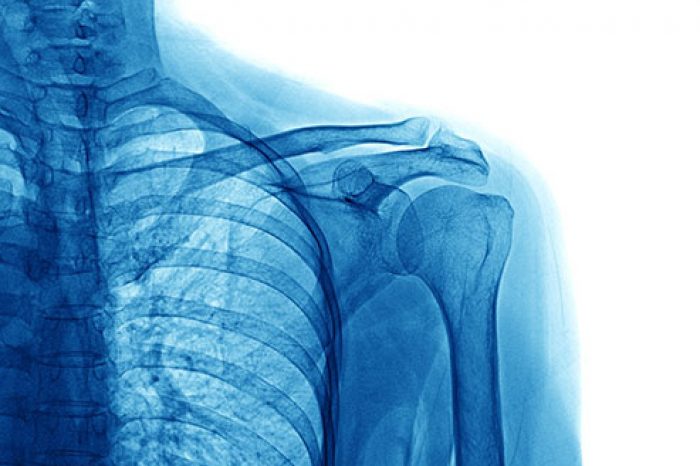
Tendons and ligaments consist of linear collagen fibers and a supporting matrix. The fibers are oriented along the direction of force on the tendon or ligament. Normal tendons and ligaments are comprised of densely packed and cross-linked type I collagen. A tendon connects a muscle to bone and a ligament connects bones.
Acute catastrophic tears of normal tendon are rare, and overuse injuries are more common. Tendinopathy can be found within the main body of the tendon, its insertion site on bone (enthesis), and the structures around the tendon (peritenon). These different forms of tendinopathy can coexist within the same tendon, and to maximize outcomes treatment should be tailored to the exact pathology.
Histologic studies examining the tendon under a microscope have shown an absence of acute inflammatory cells, and micro-injury to the normal tendon architecture. Tendon healing after an injury is characterized by new collagen production, and restoring and remodeling the tendon (Brown et al, 2016).
Surgical repair can be problematic, as repaired tendon rarely achieve functionality equal to that of the original tendon. Repaired tendon is not regenerated after the repair, and instead the injured tissue is replaced with “reactive scar” rich in collagen type III. This makes the tendon mechanically weaker than the original calcified cartilage at the enthesis, and has increased the interest in using regenerative orthopedics to augment the healing process (Kovacevic & Rodeo, 2008).
Following an injury, the mix of type III and I collage change. The new collagen fibers are smaller in diameter and less densely packed reducing the stiffness and strength of the ligament. The collagen fibers also exhibit an abnormal cross-linked pattern and can exhibit “greater stress relaxation” making the ligament to elongate more when stressed (Frank et al 1999; Thornton et al 2000).
This laxity and can lead extra stress on the joint and possibly early onset post-traumatic osteoarthritis (Øiestad et al 2009).
Regenerative injections require a multifactorial approach, including precise diagnosis, choosing the most appropriate cell type and accurately placing the biologic injection.
The majority of tendons and ligaments are superficial and can be assessed with musculoskeletal ultrasound. Unfortunately, ultrasonography still remains user dependent (Hinsley et al 2014), but a skill sonographer can ensure appropriate assessment and categorization of a ligament or tendon injuries.
Ultrasound can help accurately characterizing the injury and this can help in selecting the appropriate intervention to improve outcomes.
The biologic injection should be appropriate for the specific tissue pathology or injury, and this can vary based on body part and severity of injury.
There are over 40 different commercial platelet-rich plasma (PRP) kits and they each produce a different cell product, and stem cells and growth factors can be isolated from bone marrow or adipose (fat) cells. In addition, amniotic growth factor injections are commercially available. Each of these regenerative injections should be chosen based on the specific pathology state in the tissue as the have a different mix of growth factors, cellular mix and bioactive scaffolding.
It is important that your practitioner is well versed in all of these different regenerative injections so that they can advise you on the right injection for you.
Ultrasound plays a role in not only confirming the diagnosis, but guiding injections in or around tendons or ligaments. Regenerative injections must be placed with precision. If you are considered using platelet-rich plasma (PRP) or other stem cell-based autologous injections for soft tissue injuries or degenerative pathology within tendons and ligaments ensure that the cells are accurately placed. Learn more about how to choose the right physician (here).
Make sure that your physician has adequate training in
musculoskeletal ultrasound. One way to make sure that your physician has
the appropriate training is they have taken and passed the RMSK
certification.
Brown MN, Shiple BJ, Scarpone M. Regenerative Approaches to Tendon and Ligament Conditions. Phys Med Rehabil Clin N Am. 2016 Nov;27(4):941-984.
Frank C, Shrive N, Hiraoka H, et al. Optimization of the biology of soft tissue repair. J Sci Med Sport 1999;2(3):190–210.
Hinsley H, Nicholls A, Daines M, Wallace G, Arden N, Carr A. Classification of rotator cuff tendinopathy using high definition ultrasound. Muscles Ligaments Tendons J. 2014 Nov 17;4(3):391-7.
Kovacevic D, Rodeo S. Biological augmentation of rotator cuff tendon repair. Clin Orthop Relat Res 2008;466:622–33.
Øiestad BE, Engebretsen L, Storheim K, Risberg MA. Knee osteoarthritis after anterior cruciate ligament injury: a systematic review. Am J Sports Med. 2009 Jul;37(7):1434-43.
Thornton G, Leask G, Shrive N, et al. Early medial collateral ligament scars have inferior creep behavior. J Orthop Res 2000;18:238–46.
Adductor longus selective tenotomy is a modern surgical treatment for chronic groin pain that offers faster recovery and better outcomes than traditional full release surgery. The adductor longus, an inner thigh
Read MoreDiscover how ultrasound helps diagnose plantar fat pad atrophy, a leading cause of ball-of-foot pain. Learn about symptoms, thickness cutoffs, and why early detection matters for relief.
Read More